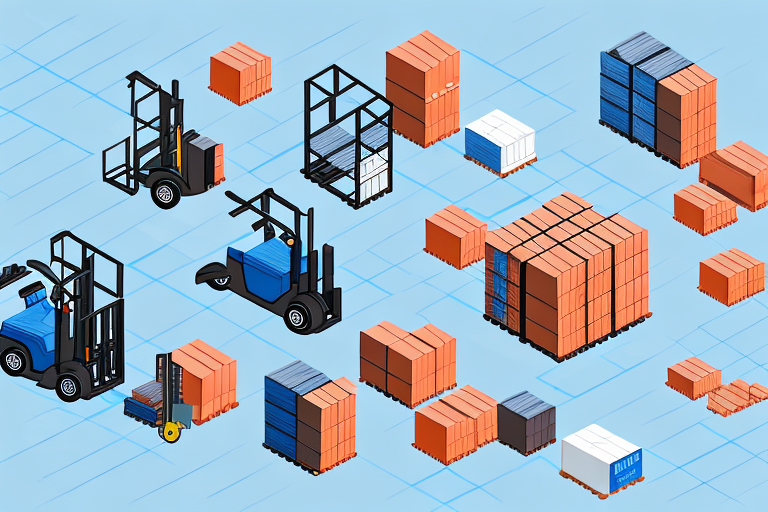Finished Goods Inventory: A Core Warehouse Metric
In the world of warehousing, measuring inventory performance is critical for driving efficiency and profitability. One of the core metrics that businesses focus on is Finished Goods Inventory. This metric measures the number of finished goods that a company has on hand, ready to be sold or shipped to customers. Understanding and managing this metric is essential for any company that produces and sells goods. In this article, we will explore the importance of measuring finished goods inventory, understand how to manage it, and how to optimize it for business success.
The Importance of Measuring Finished Goods Inventory
Accurate measurement of finished goods inventory is critical for several reasons:
- Meeting Customer Demand: Keeping track of inventory levels ensures that the business can meet customer demand. If inventory levels are too low, the business risks losing sales and customer loyalty. Conversely, if inventory levels are too high, the business may tie up capital in unused inventory, increasing the risk of obsolete goods.
- Assessing Warehouse Efficiency: Measuring finished goods inventory allows businesses to identify inefficiencies within the warehouse, enabling targeted improvements in operations.
- Financial Reporting and Analysis: Accurate inventory records are necessary for calculating the cost of goods sold (COGS), a key component of a company's income statement. This information is used by investors, creditors, and other stakeholders to evaluate a company's financial performance.
According to a 2023 Warehouse Efficiency Report by ShipScience, businesses that maintain optimal inventory levels can reduce storage costs by up to 20% and increase order fulfillment rates by 15%.
Understanding Finished Goods Inventory Management
The process of managing finished goods inventory begins when the goods are completed and ready for sale or shipment. The inventory is then stored in the warehouse, where it is tracked and monitored until it is sold or shipped. During this period, the inventory is subject to various risks, including damage, theft, and obsolescence. Therefore, careful management of the inventory is necessary to maintain its quality and value.
Key components of finished goods inventory management include:
- Accurate Tracking and Monitoring: Implementing systems to track inventory levels in real-time.
- Proactive Inventory Replenishment: Ensuring that inventory is replenished before it runs out.
- Effective Risk Mitigation Strategies: Protecting inventory from damage, theft, and obsolescence through appropriate measures.
One crucial aspect of inventory management is forecasting demand. By accurately predicting demand, businesses can maintain sufficient inventory levels to meet customer needs without overstocking. This involves analyzing historical sales data, market trends, and other factors that may impact demand. According to the Supply Chain Quarterly, companies that excel in demand forecasting can achieve a 10-30% reduction in excess inventory.
Key Performance Indicators (KPIs) for Finished Goods Inventory
Key Performance Indicators (KPIs) are metrics used to track progress toward specific goals. For finished goods inventory, common KPIs include:
- Inventory Turns: Measures how quickly inventory is sold and replenished.
- Days Sales of Inventory (DSI): Indicates the average number of days it takes to sell the entire inventory.
- Inventory Carrying Costs: Calculates the total cost of holding inventory, including storage, insurance, and depreciation.
- Order Fill Rate: Measures the percentage of customer orders fulfilled completely and on time.
- Percentage of Obsolete or Expired Inventory: Tracks the proportion of inventory that is no longer usable or sellable.
These KPIs help businesses assess the effectiveness of their finished goods inventory management policies and procedures. For instance, a high inventory turnover rate typically indicates efficient inventory management, whereas a low rate may suggest overstocking or slow-moving products.
Improving KPIs can lead to substantial benefits. A study by McKinsey & Company found that optimizing inventory management can reduce costs by 5-15% and increase customer satisfaction by up to 20%.
The Role of Technology in Managing Finished Goods Inventory
Effective management of finished goods inventory heavily relies on technology and automation. Utilizing inventory management software and other tools allows businesses to:
- Monitor inventory levels in real-time
- Track inventory movement within the warehouse
- Conduct real-time inventory analysis to identify trends and potential risks
These capabilities enable businesses to make informed decisions about inventory management, leading to improved efficiency, lower costs, and higher customer satisfaction.
Automation is a key benefit of using technology in inventory management. For example, businesses can set up automatic reorder points for products, triggering a purchase order when inventory levels fall below a certain threshold. This ensures that businesses always have enough inventory on hand to meet customer demand without manual intervention.
Additionally, integrating inventory management systems with other platforms such as accounting software or customer relationship management (CRM) tools provides a holistic view of operations. This integration facilitates more informed decision-making based on sales trends, customer demand, and financial performance.
According to the ShipScience Technology Trends Report, companies that leverage advanced inventory management technologies can see up to a 25% increase in operational efficiency.
How to Calculate and Analyze Finished Goods Inventory Turns
Inventory Turns is a metric that indicates how often inventory is sold and replaced over a specific period. To calculate inventory turns:
- Determine the Cost of Goods Sold (COGS) for the period.
- Calculate the Average Inventory Value by adding the beginning and ending inventory levels and dividing by two.
- Divide COGS by the Average Inventory Value.
Formula:
Inventory Turns = Cost of Goods Sold / Average Inventory Value
This metric provides insight into the efficiency of the inventory management process. A higher number of inventory turns typically indicates efficient inventory management, whereas a lower number may suggest overstocking or slow-moving inventory.
In addition to calculating inventory turns, businesses should regularly analyze:
- Inventory Levels: Ensure that inventory is maintained at optimal levels.
- Lead Times: Understand the time taken from ordering to receiving inventory.
- Customer Demand: Monitor changes in customer preferences and purchasing behavior.
Identifying slow-moving or obsolete inventory is crucial. This type of inventory ties up valuable resources and can negatively impact cash flow. Regularly reviewing inventory levels and identifying such items allows businesses to take steps to reduce inventory levels and free up resources for more profitable activities.
Best Practices for Optimizing Finished Goods Inventory Levels
To optimize finished goods inventory levels, businesses should implement several key strategies:
- Effective Demand Forecasting: Utilize advanced analytics to predict future demand accurately.
- Lean Inventory Management: Adopt lean principles to minimize waste and maximize efficiency.
- Regular Inventory Audits: Conduct frequent audits to ensure inventory accuracy and integrity.
- Supplier Management: Develop strong relationships with suppliers to ensure timely and reliable delivery of goods.
- Minimize Lead Times: Streamline processes to reduce the time between ordering and receiving inventory.
- Reduce Carrying Costs: Improve warehouse operations to lower storage and handling costs.
Implementing a Just-In-Time (JIT) inventory system is another effective strategy. This system involves ordering and receiving inventory only when it is needed for production or to fulfill customer orders. By reducing the amount of inventory held in stock, businesses can minimize carrying costs and reduce the risk of excess inventory becoming obsolete or outdated. However, JIT requires careful planning and coordination with suppliers to ensure timely delivery of materials and products.
According to the ShipScience JIT Inventory Benefits Study, businesses that implement JIT systems can reduce inventory holding costs by up to 30% while maintaining high service levels.
Common Challenges in Managing Finished Goods Inventory
Effective finished goods inventory management comes with its set of challenges, including:
- Obsolescence: The risk of inventory becoming outdated due to changing market trends or technological advancements.
- Theft and Damage: Physical risks that can lead to loss or degradation of inventory.
- Demand Forecasting: Accurately predicting customer demand to avoid overstocking or stockouts.
- Supplier Relationships: Managing and maintaining reliable relationships with suppliers to ensure timely delivery.
- Optimizing Warehouse Operations: Streamlining processes to improve efficiency and reduce costs.
Addressing these challenges requires a comprehensive inventory management strategy that incorporates technology, effective forecasting, strong supplier relationships, and robust security measures.
Strategies for Reducing Excess Finished Goods Inventory
Excess finished goods inventory poses significant risks, including increased carrying costs and potential obsolescence. To mitigate these risks, businesses can employ several strategies:
- Sales and Promotions: Implementing discounts or promotions to accelerate the sale of excess inventory.
- Reducing Lead Times: Shortening the time between ordering and receiving inventory to better match supply with demand.
- Advanced Inventory Forecasting: Leveraging technology to improve the accuracy of demand forecasts.
- Just-In-Time (JIT) Inventory Management: Aligning inventory purchases closely with actual demand.
- Data Analytics: Utilizing data to identify trends and shifts in customer demand, enabling proactive inventory adjustments.
Implementing these strategies can help businesses maintain optimal inventory levels, reduce waste, and improve overall financial performance.
The Impact of Accurate and Efficient Finished Goods Inventory Management on Business Success
Accurate and efficient finished goods inventory management has a profound impact on a business's success:
- Improved Customer Satisfaction: Ensuring that products are available when customers need them enhances satisfaction and loyalty.
- Cost Reduction: Minimizing excess inventory lowers storage costs and reduces the risk of obsolescence.
- Enhanced Efficiency: Streamlined inventory processes lead to faster order fulfillment and better use of resources.
Conversely, poor inventory management can result in lost sales, decreased profits, and damage to a business's reputation. By focusing on effective inventory management strategies, businesses can ensure long-term success and realize their full potential.
Future Trends in Finished Goods Inventory Management
As technology continues to evolve, the landscape of finished goods inventory management is expected to undergo significant changes. Future trends include:
- Advanced Analytics and AI: Utilizing artificial intelligence and machine learning to enhance demand forecasting and inventory optimization.
- Automation and Robotics: Implementing automated systems and robotics to improve warehouse operations and reduce manual errors.
- Integration of IoT Devices: Using Internet of Things (IoT) devices for real-time tracking and monitoring of inventory.
- Blockchain Technology: Enhancing transparency and traceability in the supply chain through blockchain.
- Drones and Autonomous Vehicles: Employing drones and autonomous vehicles for inventory management and goods transportation.
- Growth of E-Commerce: Adapting inventory management practices to meet the demands of expanding online marketplaces.
Staying abreast of these trends and integrating new technologies will be crucial for businesses to maintain competitive advantage and optimize their inventory management practices.
Case Studies: Successful Examples of Managing and Optimizing Finished Goods Inventory
Studying successful case studies provides valuable insights into effective finished goods inventory management. Notable examples include:
- Amazon: Amazon has developed a highly sophisticated inventory management system that leverages advanced algorithms and robotics to ensure rapid order fulfillment and minimal inventory holding costs.
- Zappos: Zappos utilizes a robust inventory management system that focuses on customer satisfaction through reliable stock levels and efficient logistics.
- Toyota: Toyota's implementation of lean inventory management techniques has led to significant reductions in waste and improvements in operational efficiency.
- Walmart: Walmart employs integrated inventory management systems that connect suppliers, distribution centers, and stores to maintain optimal inventory levels across its vast network.
These companies demonstrate how effective inventory management can lead to enhanced efficiency, reduced costs, and superior customer service.
Tips for Communicating with Stakeholders about Your Warehouse's Finished Goods Inventory Performance
Effective communication is essential for ensuring that stakeholders understand the importance of finished goods inventory management. Here are some tips:
- Use Data-Driven Metrics: Present inventory performance using clear and relevant KPIs to provide an objective view of inventory health.
- Highlight the Impact on Customer Satisfaction: Explain how effective inventory management contributes to meeting customer demands and enhancing satisfaction.
- Conduct Regular Performance Reviews: Share periodic reports and updates on inventory metrics to keep stakeholders informed of progress and challenges.
- Develop Clear and Concise Messaging: Communicate inventory performance in an understandable manner, avoiding technical jargon when possible.
- Address Performance Issues Transparently: If there are inventory management issues, openly discuss them and present strategies for resolution.
By maintaining transparent and consistent communication, businesses can build trust with stakeholders and ensure alignment on inventory management goals.
Conclusion: The Bottom Line on Measuring and Managing Your Warehouse's Finished Goods Inventory
Effective finished goods inventory management is critical for any business that produces and sells goods. By measuring and managing inventory accurately, businesses can:
- Improve operational efficiency
- Reduce costs associated with excess inventory
- Enhance customer satisfaction and loyalty
- Support informed financial reporting and analysis
Achieving these benefits requires a focus on key performance indicators, leveraging technology and automation, and maintaining effective communication with stakeholders. By implementing these strategies, businesses can optimize their finished goods inventory levels and set the stage for long-term success.




















